LPWA Module Series
BG95&BG96 Compatible Design
BG95&BG96_Compatible_Design 31 / 47
In order to enhance the reliability and availability of the (U)SIM card in applications, please follow the
criteria below in (U)SIM circuit design:
Keep the placement of (U)SIM card connector as close to the module as possible. Keep the trace
length as less than 200 mm as possible.
Keep (U)SIM card signals away from RF and VBAT traces.
Assure the ground between the module and the (U)SIM card connector short and wide. Keep the
trace width of ground and USIM_VDD no less than 0.5 mm to maintain the same electric potential.
Make sure the bypass capacitor between USIM_VDD and USIM_GND less than 1 μF, and place it as
close to (U)SIM card connector as possible. If the system ground plane is complete, USIM_GND can
be connected to the system ground directly.
To avoid cross-talk between USIM_DATA and USIM_CLK, keep them away from each other and
shield them with surrounded ground. USIM_RST should also be ground surrounded.
In order to offer good ESD protection, it is recommended to add a TVS diode array with parasitic
capacitance not exceeding 15 pF. In order to facilitate debugging, it is recommended to reserve
series resistors for the (U)SIM signals of the module. The 33 pF capacitors are used for filtering
interference of EGSM900. Please note that the (U)SIM peripheral circuit should be close to the
(U)SIM card connector.
The pull-up resistor on USIM_DATA line can improve anti-jamming capability when long layout trace
and sensitive occasion are applied, and should be placed close to the (U)SIM card connector.
1. eSIM function of BG95 is optional. If eSIM is selected, then the external (U)SIM cannot be used
simultaneously.
2. USIM_DET function of BG95 is under development.
4.8. UART Interfaces
BG95/BG96 provides three UART interfaces: Main UART, Debug UART and GNSS UART. The main
UART supports hardware flow control and is used for data transmission and AT command communication.
The debug UART is used for module debugging and log output. The GNSS UART is used for GNSS data
and NMEA sentence output. The default baud rate of UARTs is 115200bps.
Since the UART interface power domains of both BG95 and BG96 are 1.8V, a level translator should be
used if customers’ application is equipped with a 3.3V UART interface. The voltage-level translator
TXS0108EPWR provided by Texas Instruments is recommended. Please visit http://www.ti.com for more
information.
The following figure shows a reference design. For details, please refer to document [1] and [2].

